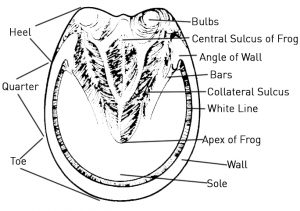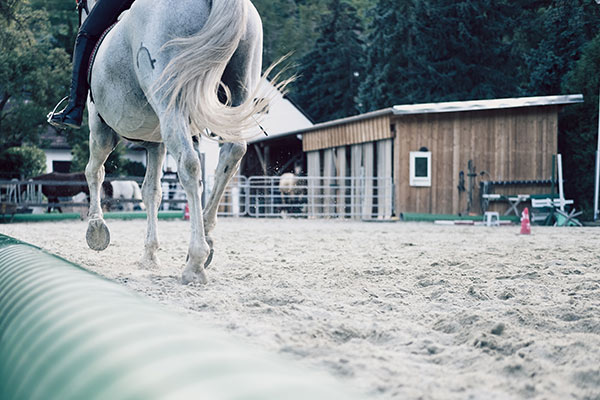Looking after your horse’s hooves is imperative for a healthy and happy horse. There are many issues that can occur if the hoof isn’t looked after, so it’s your job to ensure regular checks are carried out. Here are our top horse hoof care tips.
Structure of the hoof

Firstly, let’s take a brief look at the structure of a horse’s hoof. It’s a structure made up of many different elements and if it’s kept healthy it will protect the softer elements of the hoof while taking the huge weight of the horse.
The sole protects the softer and more sensitive elements underneath. The white line joins the sole and inner to protect the pedal bone and help prevent infection from unwanted bacteria.
The inner wall has a high moisture content and protects from high impact movement. The outer wall is extremely strong and is able to hold the weight of the horse – it protects all the inner elements of the hoof. This must be looked after well and if any damage comes to the outer wall through poor or incorrect nutrition, injuries or other issues then it will break down the entry into the hoof.
The bar strengthens the heel area, running alongside the frog and controls movement at the back of the hoof. The angle of the bar helps support the weight of the horse and takes the initial impact.
The frog is the most important element of the horse’s hoof and needs to be looked after or issues can develop and lead to lameness. The frog is thick and leathery and helps absorb shock; it also contains nerves, so the horse can feel where he’s standing. Towards the back of the foot in the centre of the frog is the central sulcus. The central sulcus should be wide and quite shallow in optimal health. If it becomes weak and narrow it can cause it to deepen which can then harbour bacteria and lead to infection.
Horse Hoof Care Tips
To make sure you have a happy horse and keep all elements of the hoof as healthy as possible here are our top tips.
-
What’s normal
Become familiar with your horse’s hooves. Know what they should look like in optimal health so that if anything changes you’ll be more likely to spot it. Any sign of something not looking quite right then get it checked before it develops into something more serious. Better to be safe than sorry!
-
Check the hooves
Regularly check hooves for stones and anything that may have become lodged during outdoor activity. Check the balance of the hoof. If the horse is shod then check there are no gaps between the shoe and the hoof. If the horse is unshod then the sole of the hoof should not touch the floor.
-
Farrier Care

Your horse should have regular farrier visits. The farrier will trim and balance the hoof; they’ll also shoe the horse if needed. After your farrier has visited keep an eye on the horse for a couple of days to make sure there are no problems. If you do experience any issues then call the farrier immediately.
-
Keep a look out
Keep an eye on the hooves looking for common issues occurring.
Bruised sole: This is exactly as it sounds… a bruised sole! Caused by standing on a hard object or high impact to the sole causing bruising to occur. This will cause lameness that will get worse if not rested. Keep an eye out for red or bruised areas on the sole.
Laminitis: Read our laminitis article on what to look for. The cause is usually down to diet with the digestive system being unable to cope with soluble carbohydrates.
Thrush: Usually brought on from being in damp conditions, whether that be from muddy walks or poor stable care. The main symptom to look for is a black discharge around the frog area and this will have an unpleasant odour to it. If left it can lead to lameness as the bacterial infection will affect the internal elements of the hoof. This can be prevented with regular care and attention to the hooves.
Infections: Check for swelling and any signs that an infection might be present. If the area is sensitive it could be a sign of infection that needs treating and in some cases the pus may need draining from the infected area. Any swelling or inflammation will cause pressure and therefore pain for your horse. Infections are the most common cause of lameness.
The Mayo Mattress is a supremely comfortable stable mat. At times of discomfort the mattress will provide cushioning for sore hooves and make for a comfortable resting area.
-
Summer care
In the Summer months the heat can have an effect on your horse’s hooves. If not looked after they can get dry and brittle. This is due to the change in moisture – if the hoof is continuously changing from a moist to a dry climate It will cause issues. The hoof will expand to hold moisture when wet and then contract when dry. Continuous actions like this will cause dry, cracked hooves.
Try to manage the moisture levels your horse is exposed to on a day to day basis to reduce damage to the hoof. Also, regularly apply oil to the hoof to help keep it nourished.
What issues have you experienced with your horse’s hooves and what checks do you make to ensure they are healthy?
